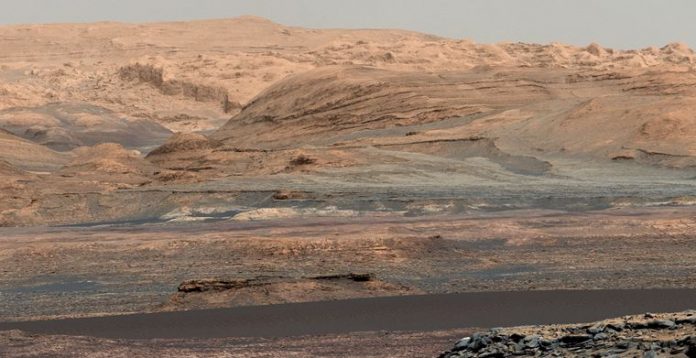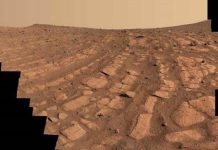
Dec. 27 (UPI) — It was a big year for space flight and exploration, as private companies kicked a 21st century space race into full gear. SpaceX launched 21 missions as others watched new vessels undergo testing and some escaped the Earth’s atmosphere for the first time.
NASA celebrated its 60th birthday in October, the same year it announced goals to take humans back to the moon, explored asteroids and landed a new rover on Mars. And in Asia, China launched more rockets than any other country as Japan’s space agency actually landed a probe on an asteroid for the start of a two-year mission.
SpaceX’s Falcon Heavy
It was a big year for the private space company. SpaceX launched its first spy satellite, several communications satellites and a handful of space station resupply missions. But the company’s most-talked about feat was the debut launch of its Falcon Heavy rocket, the world’s most powerful rocket.
The Falcon Heavy’s maiden voyage released Elon Musk‘s Tesla Roadster into a heliocentric Mars-Earth orbit. SpaceX expects the Falcon Heavy to power future manned missions to the space station, moon and Mars.
Asteroids
NASA has spoken frequently of returning astronauts to the moon and eventually sending humans to Mars. But in 2018, several space agencies settled for asteroid missions.
Hayabusa-2, the probe launched by Japan’s space agency, JAXA, met up with its target, Ryugu, over the summer. In October, Hayabusa-2 dropped several landers onto the asteroid’s surface.
Eventually, Hayabusa-2 will briefly join its landing probes on Ryugu. Next year, the probe is scheduled to execute a series of touch-and-go landings, during which it will attempt to collect rocks to be returned to Earth for analysis.
“Studying Ryugu could tell humanity not only about Ryugu’s surface and interior, but about what materials were available in the early solar system for the development of life,” according to NASA.
NASA celebrated its own asteroid mission success. In early December, NASA’s probe OSIRIS-REx rendezvoused with its target, Bennu.
Over the course of the next year, the probe will circle and study Bennu, executing a series of flybys for a close look at some of its unique features. The spacecraft will swoop by the asteroid’s equator and poles. A few approaches will put the probe within 4.4 miles of the asteroid’s surface.
While spacecraft visited asteroids, a space rock also paid a visit to our solar system. In February, a massive orb named ‘Oumuamua became the first intergalactic object observed by scientists. Scientists spent the following months tracking the object’s path around the sun and back out toward interstellar space.
Researchers wavered on whether ‘Oumuamua is an asteroid or a comet, but ultimately decided the object is a very dirty, rock-filled comet. Scientists also determined ‘Oumuamua has been tumbling about the universe for at least a billion years.
Mars
Though NASA is still a ways from sending astronauts to Mars, it did put another lander on the Red Planet. Late last month, NASA’s Insight lander touched down on the Martian surface.
“Its new home is Elysium Planitia, a still, flat region where it’s set to study seismic waves and heat deep below the surface of the Red Planet for a planned two-year mission,” NASA announced.
Just a few weeks later, InSight placed a seismometer on Mars’ surface for the first time in history. Next year, InSight will hammer a 16-foot heat probe into the Martian soil.
Private space companies
SpaceX was the busiest private space company in 2018, but several competitors reached noteworthy milestones.
On Dec. 13, Virgin Galactic’s rocket-powered spaceplane, SpaceShipTwo, reached its highest altitude yet, more than 51.5 miles. Virgin Galactic hopes the vehicle will carry tourists to the edge of space and back in the near future.
A spinoff of Virgin Galactic, Virgin Orbit, also conducted several test flights of a satellite-launching plane-rocket duo this year. The flights proved the concept and technology is sound and the rocket could begin launching payloads mid-flight from the belly of a 757 in 2019.
Blue Origin, the space company founded by Amazon CEO Jeff Bezos, and its reusable rocket, New Shepard, also conducted multiple test flights in 2018. Like Virgin Galactic, Bezos’ company aims to carry tourists into space.
China
In October, Zhuque-1, the first privately developed Chinese rocket nearly succeeded in carrying a small satellite into orbit. Its first two stages operated as expected, but the third stage malfunctioned and the rocket and payload were destroyed.
Two new companies, OneSpace and iSpace, have entered China’s private space race. The competition, buoyed by the support of China’s well-funded and quickly maturing space agency, could see private Chinese space companies rival those in the United States.
While China’s one attempt at a private rocket launch ended in failure, the nation’s government-funded space agency, the China National Space Administration, launched 35 rockets in 2018 — more than all public and private rockets launched from the United States.
Delays and disappointment
The beginning of 2018 brought excitement for the prospect of American-made rockets and spacecraft once again carrying astronauts to the International Space Station.
SpaceX and Boeing were expected to launch tests flights of their crewed vehicles, but in October, the companies acknowledged neither of their space station taxis, SpaceX’s Crew Dragon and Boeing’s CST-100 Starliner, would make it off the ground until next year.
The delays have called the Commercial Crew Program’s timeline into question. Since the Space Shuttle was retired in 2011, NASA has relied on Russia’s space agency, Roscosmos, to ferry American astronauts back and forth from the space station.
In October, a two-man crew, one NASA astronaut and one Russian cosmonaut, were forced to abandon their Soyuz craft after the rocket carrying it into space malfunctioned. The duo parachuted to safety, but the rocket failure highlighted NASA’s predicament.
Roscosmos and NASA’s space station transit agreement ends at the end of 2019, and there are concerns neither SpaceX’s Crew Dragon nor Boeing’s Starliner will be ready to fly astronauts to ISS by the end of next year.





